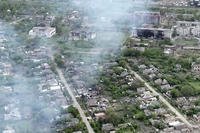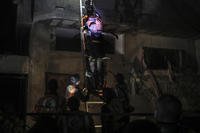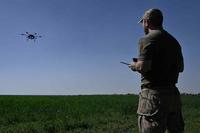The U.S. military on Tuesday backed up Iraqi claims that eastern Mosul has been liberated after 100 days of urban combat marked by incessant ISIS counterattacks, more than 550 U.S. airstrikes, lulls in the fighting and tactical resets.
After a meeting Monday in Baghdad with Prime Minister Haider al-Abadi, Sheikh Humam Hamoudi, the deputy speaker of Parliament, said, "We completed the total liberation of the left bank of Mosul and this is a gift to the Iraqi people."
In statements Tuesday, Army Lt. Gen. Stephen Townsend, commander of Combined Joint Task Force-Operation Inherent Resolve, said that clearing operations are still underway in the eastern half of the city, which is split by the Tigris River, and warned of tougher fighting ahead in the more densely populated western sector.
However, the progress thus far is "a monumental achievement for not only the Iraqi Security Forces and sovereign government of Iraq, but all Iraqi people," he said.
"This would have been a difficult task for any army in the world," Townsend said of the Mosul offensive to oust the Islamic State of Iraq and Syria that began Oct. 17.
"And to see how far the Iraqis have come since 2014, not only militarily, but in their ability to put their differences aside and focus on a common enemy, gives real hope to the people of Iraq that -- after years of fighting and instability -- peace and security are attainable," he said.
Townsend cautioned that there is a "long way to go" before Mosul is fully liberated. "The fight for western Mosul is likely to be even tougher than the eastern side," he said.
The first few weeks of the Mosul offensive focused on clearing the outskirts and isolating the city, with the ISF pushing from the south and Kurdish Peshmerga forces from the east and north.
Elite Iraqi Counter Terror Services units then passed through Kurdish lines to make the first attacks into the city, but the drive frequently stalled as ISIS attacked with car bombs, or Vehicle Borne Improvised Exploding Devices. The VBIED attacks averaged five per day, the U.S. said.
U.S. officials also said that ISIS has mounted what was described as a "three-dimensional defense -- from rooftops, from the streets, and from a maze of tunnels.
The offensive in the eastern sector paused in mid-December as the Iraqis regrouped and drew up a new plan with the aid of hundreds of more U.S. advisers.
When the attack resumed Dec. 29, the drive by the CTS into the eastern sector was joined by units of the ISF and the Iraqi federal police pushing from the south to divide the ISIS defenders.
Since Oct. 17, U.S. and coalition aircraft have carried out 558 airstrikes in assistance of the ISF, using 10,115 munitions against ISIS, according to CJTF-OIR.
The airstrikes have destroyed at least 151 vehicle bombs, 361 buildings or facilities, 140 tunnels, 408 vehicles, 392 bunkers, 24 anti-air artillery systems, and 315 artillery or mortar systems.
Iraqi commanders at times during the offensive have said they were taking heavy casualties in the drive on Mosul, but they have yet to release official figures. The Iraqi commanders also claimed to have killed more than 2,000 ISIS fighters.
Before the offensive began, a U.S. military spokesman said that 3,000 to 5,000 ISIS fighters were in Mosul, but officials have cautioned that the estimates were only preliminary.









